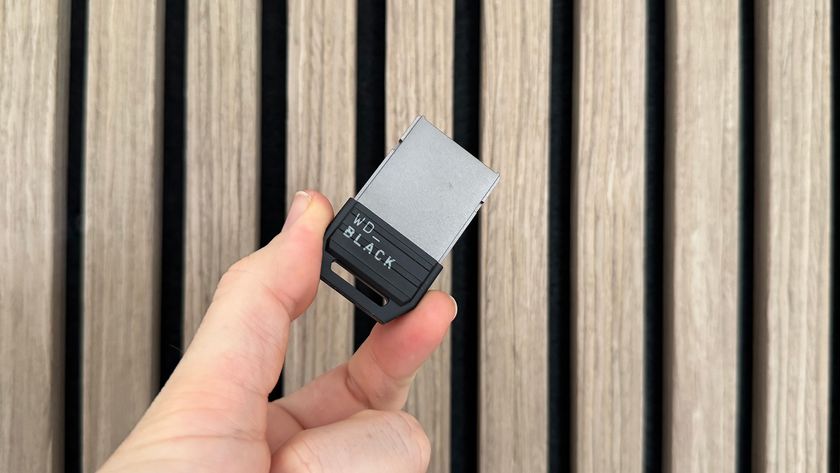12DOVE Verdict
The RedMagic 9S Pro is an extremely efficient performer, offering an incredible amount of power and a particularly strong battery life. Its display sits as the jewel in this crown, though concerns around continued update support does make it one for those who upgrade their tech regularly.
Pros
- +
Slick aesthetic design
- +
Crisp display with smooth motion
- +
High-end performance
- +
Excellent value for money
- +
Much improved UI
- +
Long battery life
Cons
- -
Marginal spec improvements over previous model
- -
Updates may be needed in the future
Why you can trust 12DOVE
The race to the top of the best gaming phone leaderboard has been a contentious one over the years, but two names have emerged as leaders. Nubia now faces off against Asus annually, but its affordable price point and refusal to compromise on raw power makes it a worthy competitor. The latest RedMagic 9S Pro brings in an overclocked version of the Snapdragon 8 Gen 3 chip, a 6500mAh battery, touch-capacitive triggers, and a 6.8-inch AMOLED display running at 120Hz to battle this time around, inching ever so slightly ahead of its previous 9 Pro specs. Those are iterative upgrades compared to the older generation, but considering there haven’t been any major updates to the Snapdragon SOC since then, it’s still a contender for one of the best gaming phones on the market.
| Price | $649 / £579 |
| Display | 6.8-inch 2480 x 1116 AMOLED (120Hz) |
| Processor | Qualcomm Snapdragon 8 Gen 3 Leading Version |
| RAM | 12GB / 16GB LPDDR5X |
| Storage | 256GB / 512GB |
| OS | Android 14 |
| Cameras | 50MP Main, 50MP Ultra-Wide, 2MP Macro, 16MP Front |
| Battery | 6,500mAh |
| Water resistance | None |
| Dimensions | 6.46 x 3.01 x 0.37 inches |
| Weight | 229g |
Design
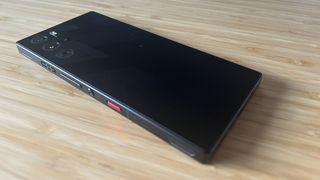
At 6.46 x 3.01 x 0.37 inches, the RedMagic 9S Pro measures in every so slightly thicker and taller than the Asus ROG Phone 8 Pro (6.45 x 3.02 x 0.35 inches). Still, that’s a marginal difference - in everyday life, this feels like a similar form factor both in the hand and pocket, especially considering it’s only 4g heavier. The actual shape differentiates the 9S Pro almost immediately, though.
Whereas Asus has still kept some curvature to its corners, the 9S Pro is almost severe in its straight lines. Flat sides, harsher corners, and a straight back make for a particularly angular form factor - one that both impressed and frustrated in testing. There isn’t a lot of purchase to be found towards the rear of the device, which meant my hands were sometimes curled in on themselves with nothing to grip when holding horizontally. This is a concern with the majority of flat gaming phones, but others like Asus employ a slightly raised rear panel to compensate. Why did it impress? Because for its slight comfort misgivings, it looks sexy as hell. Those harsher lines make for a particularly svelt feel and a slick look overall, even if the brushed effect on the back of my Sleet version isn’t to my particular liking.
The 9S Pro is available in this black colorway, but also drops the metallic effect on the Frost (clean white), Cyclone (gray), and Snowfall (patterned white) models. I would have likely preferred one of these simpler designs, as the slight scratching sound (think running your hand across a vinyl record) when handled or placed on a surface did grow a little tiresome.
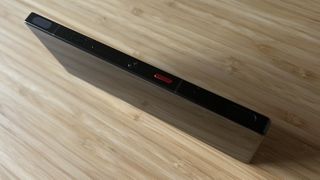
As in previous generations, the right flank packs two touch-capacitive trigger panels as well as a slider to access Nubia’s Game Lobby software, a volume rocker, and the teeny tiny lock button. I won’t lie, this threw me at the start of my testing. The circular button is incredibly easy to miss without picking up the device, but once in hand it’s positioned comfortably under the thumb. The top panel houses a 3.5mm audio out and a speaker grill, with a second located on the bottom panel alongside a centered USB-C charging port and SIM tray. A small horizontal fan grill is the only blemish on the otherwise clean left flank.
Allow me to circle back to those speakers. While asymmetrical in their placement, both grills are essentially covered by the hands when playing in landscape mode without using the triggers. The system was likely designed for the user to always be placing their hands to reach the wide-set panels on the right edge (they’re positioned right at the corner of the device, and so naturally require some arching from the finger to allow the sound to still pass through the speaker). Not all games require or even accept these inputs, though, so when my thumbs are doing more of the heavy lifting on the screen itself, I was regularly covering the speaker.
Still, for that to be my only design gripe is pretty impressive. The centered USB-C means the RedMagic 9S Pro is still fully compatible with a range of mobile controllers (the Asus ROG Phone 8 Pro’s side port kills this option for many), and everything feels solid in the hand.
I have every confidence in this device’s long-term durability, as long as it’s kept dry (there’s still no IP rating here). An aluminum chassis, Corning Gorilla Glass 5 display, and sturdy form factor make for a particularly reassuring experience.
Features
We’ll get straight to the main event here; that 6.8-inch 120Hz display running at a 2480 x 1116 resolution. This is a particularly crisp panel, taking the harsh lines of the actual design and backing them up with an incredibly sharp picture and nicely bright 1,600 nits. With incredible color vibrancy and contrast, and teeny tiny bezels around the outside, this is a sight to behold.
The display quality gives everything from YouTube videos to block-color thumb tappers the room to run with energy and a punchy aesthetic, while that adaptive refresh rate keeps motion smooth without draining the battery. This is a gaming phone, though, which means the display needs to keep up with faster taps and gestures. The panel features a 2,000Hz touch sampling rate for instantaneous input, whether you’re thumbing through menus, scrolling a webpage, or playing competitive multiplayer shooters. Compared to the iPhone 14 Pro Max I use every day, these movements felt tighter and more responsive, leading to a more sophisticated feel during gaming overall.
Everything appearing on that screen is run by the Qualcomm Snapdragon 8 Gen 3 Leading Version processor - it’s essentially the same chip powering the previous generation 9 Pro, but overclocked slightly. It’s not going to give you a massive power boost over the older model - so if you’re chasing value in your components I’d recommend taking a look at the cheaper alternative instead. Still, the 3.4GHz max clock speed of the ‘Leading Version’ is going to give you a slight edge during more demanding sessions, and beats the 3.3GHz speed of the Gen 3 inside the Asus ROG Phone 8 Pro. Configurations can pair 12GB or 16GB of LPDDR5X RAM with either 256GB or 512GB of internal storage.
Nubia has come a long way since the early days of its RedMagic operating system. While earlier phones like the RedMagic 7 Pro frequently stuttered through badly translated, garishly designed software, things feel a lot fresher here. I didn’t notice any strange translations in menus, though some quirks (like the pre-installed Booking.com app) still remain. Still, this interface is vastly improved compared to previous iterations, and feels slick, responsive, and intuitive in both everyday and gaming use.

The brand’s Game Lobby makes its return once again, a dedicated space accessed by toggling a physical slider (marked in red) on the right flank of the phone. This kickstarts a separate operating mode, bringing all your games together for a more console-like feel and housing the phone’s main fan and performance setting controls. This mode is semi-accessible in-game as well, though you’ll need to drag from the corner to access it and I’ve always found the process to be a little hit and miss. I can never seem to reliably access the software game to game, though I can generally open the overlay after a few tries. This is a separate hub for capturing screen recordings and monitoring system vitals. This is also where you’ll be making the most of those touch-capacitive trigger buttons.
Sitting inline with the phone’s flat edge, these are easy to miss at first glance - but if you’re well versed in the world of gaming phones you’ll know to look for them. With a 520Hz sampling rate, these small trigger pads essentially act as an R1 and L1 on your device, removing the need to change your thumb position when shooting. It’s a well-worn feature provided by most gaming-specific devices these days, and the implementation is identical to that of the previous generation device. I found these shoulder buttons to be nicely responsive, though, and custom controls were easily assigned and remembered for each game. I do generally prefer the physical buttons we saw on the Black Shark 5 Pro a few years ago, as it’s easy to forget exactly where the flat pads are at times. However, RedMagic’s placement right at the edge of the device’s flank means there’s very little wiggle room or guesswork.
Under the hood, a 6,500mAh battery keeps everything chugging away, with 80W fast-charging available as well. Unlike many mainstream smartphones, there’s unfortunately no wireless charging options here. During casual everyday use, I was more than able to run the phone all day without having to charge up. In fact, after a usual day of the odd Google search, group chat, and TikTok doom scrolling, I was still regularly at around 70% battery life. This will easily see you through hours of gameplay without worrying about charge.
Performance
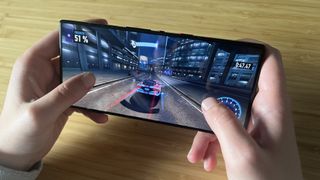
When plugged in, with those fans set to max, and everything updated, the RedMagic 9S Pro can absolutely fly. Both Wild Life Extreme and Solar Bary tests beat those of the Asus ROG Phone 8 Pro in my testing, scoring among the highest I’ve ever seen. Considering you’re getting that kind of performance for under $650 / £600, this is some seriously impressive value.
It didn’t come without its struggles, though. When I first tested the 9S Pro it rapidly became too hot to touch and powered off within around three minutes of more demanding synthetic benchmarks. This was quickly identified as a bug and after an update the pendulum couldn’t have swung further in the opposite direction. There must have been something killing that ICE 13.5 cooling system before I updated, because the gel solution kept temperatures down remarkably well once the problem was rectified. The fact that such a bug did make its way into my unit is a concern, but one that sits on a software support level rather than a physical hardware limitation. After all, we don’t know how long Nubia will continue to push these updates for - and if a glitch like that can cause frankly worrying temperatures, I would be concerned for the long-term viability of such a device. Nubia lists its update support timeline as ‘more than two years’, but that only means they have to cover you until 2026.
Let’s not slam the RedMagic 9S Pro for something it hasn’t done yet, though. The reality of its high-end performance means it’s an incredibly quick phone through everyday applications. Zipping between menus is instant, scrolling through apps is silky smooth, and running a full stack of demanding programs at the same time barely caused a sweat. Genshin Impact is my go-to for everyday testing - it’s a massive game that can give mainstream smartphones (even flagships) a headache. Set to its highest performance mode, the RedMagic 9S Pro consistently cranked out 60fps framerates, with no crashes, stuttering, or even a tripped loading screen. Animations ran fluidly and every movement was instant on the screen.
MTG Arena is another good test of a gaming phone’s performance under load. A hefty board state has crashed my iPhone 14 Pro Max more times than I can count, and simulating a game packed with token generation, weapons, stacked triggers, and graveyard pulls can sometimes be enough to swamp even a high-end SOC. The RedMagic 9S Pro whirred up a little during this test, but ultimately kept all onscreen movements smooth, ploughing through the stack and resolving almost instantly.
| Wild Life Extreme | 5,606 |
| Solar Bay | 9,423 |
Should you buy the RedMagic 9S Pro?
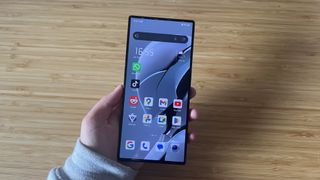
The RedMagic 9S Pro is the brand’s most powerful gaming phone to date, and it even puts the Asus ROG Phone 8 Pro through its competitive paces. Well-priced, bursting with high-end features, and backing it all up with smooth gameplay - there’s little not to love here. While the design may prove troublesome to those who want to hear their games out loud while using on-screen controls, the 9S Pro is a fantastic gaming phone for anyone after a dedicated device. My only concern in this arena is that update policy. Yes, this is a cheap product - but I had a very real issue with my test unit that could only be fixed via a patch update. Should something similar rear its head later down the line (say at the two year mark) your high-end gaming phone could be a paperweight if left unsupported. That’s why I would primarily recommend the RedMagic 9S Pro to those who regularly update their phone anyway - the dedicated mobile gamers who maintain the latest tech developments in their equipment.
How I tested the RedMagic 9S Pro
I used the RedMagic 9S Pro for a period of six weeks, with two weeks spent using the device as my daily driver. During that time I played a wide range of mobile and Xbox Game Pass streamed games, including Genshin Impact, MTG Arena, PUBG Mobile, Marvel Snap, and Forza Horizon 4. I also ran a selection of synthetic benchmark tests through the device, using 3D Mark’s Wild Life Extreme and Solar Bay tests. For more information on our testing process, check out the full 12DOVE Hardware Policy.
We’re also rounding up all the best gaming tablets and the best gaming handhelds for more portable play - and you might want to check out the best gaming earbuds to tie up the whole setup as well.

Managing Editor of Hardware at 12DOVE, I originally landed in hardware at our sister site TechRadar before moving over to GamesRadar. In between, I've written for Tom’s Guide, Wireframe, The Indie Game Website and That Video Game Blog, covering everything from the PS5 launch to the Apple Pencil. Now, i'm focused on Nintendo Switch, gaming laptops (and the keyboards, headsets and mice that come with them), PS5, and trying to find the perfect projector.

Monster Hunter Wilds director reveals upcoming "balance changes" for the action RPG, including weapon improvements and nerfs for the "unintentionally overpowered"

Gladiator's Paul Mescal and Saltburn's Barry Keoghan finally confirmed for the long-rumored Beatles cast in a first look announcing the wildest release strategy
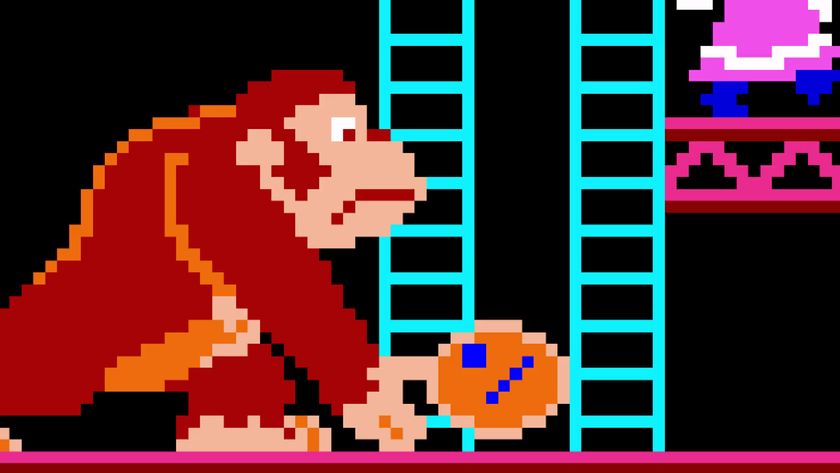
Donkey Kong player Billy Mitchell to receive over $218k in damages from YouTube creator Karl Jobst following defamation case

